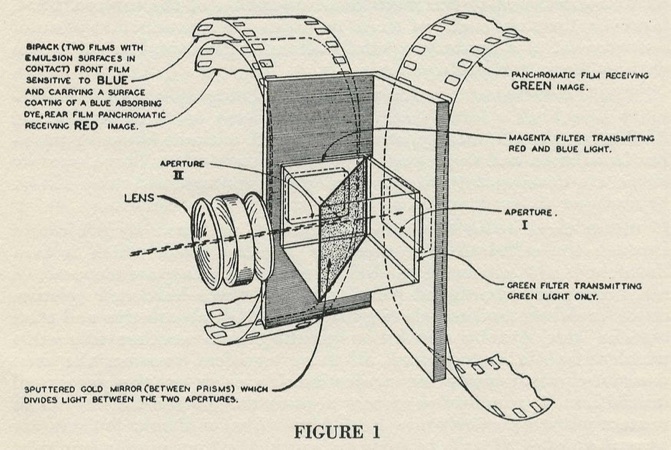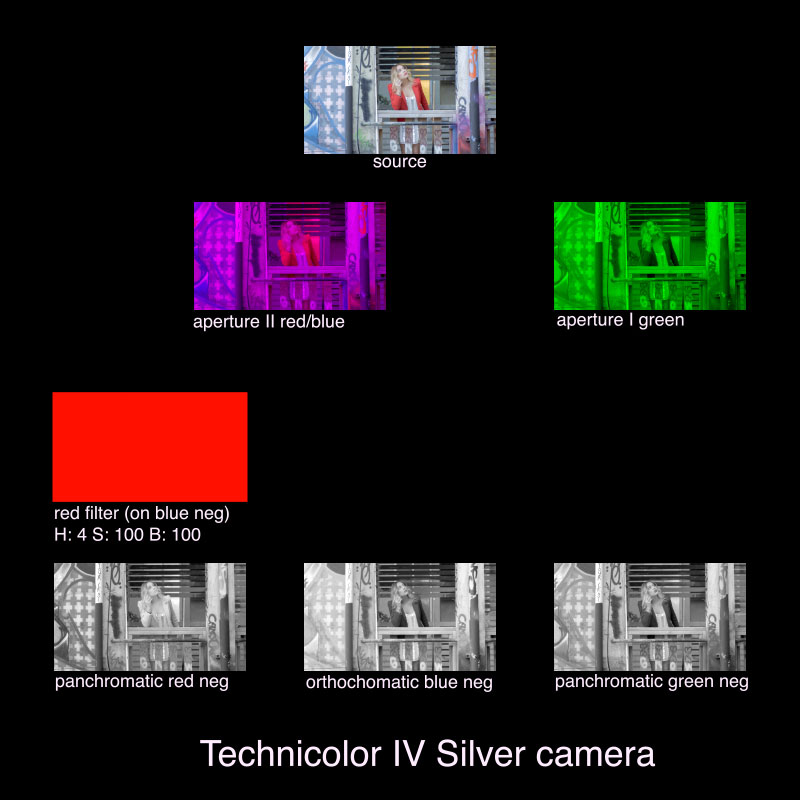Technicolor No. IV 1932-1953 silver
Late in the Technicolor No. IV era, the beamsplitter prism in the Technicolor 3-strip camera was updated from the original gold-mirrored beamsplitter to a multilayer, dichroic, color-selective beamsplitter; the so-called “silver” beamsplitter.

The gold-sputtered mirror was just that, a 1/2-coverage mirror built by splattering a reflector on a surface so that it reflected 1/2 of the light in one direction, while passing 1/2 of the light through. Dichroic beamsplitters work differently, passing specific wavelengths of light through, while reflecting other specific wavelengths.1
With the new beamsplitter the camera didn’t lose 1/2 the light before going to the negative, which meant you didn’t need big carbon arc lamps on set.
And, as a bonus, it was much more light discrete in it’s filtering.
This was the probably the version of the camera that shot the late 50’s Technicolor films, like Singin’ in the Rain.

THE CAMERA
The cool thing about this version of Technicolor No. IV, is that dichroic beamsplitters are still being used to day. It’s the same prism technology in the prism in a 3-CCD camera, and the model for what a CMOS or MOS sensor sees.
So to digitally model it, we don’t need to. The cameras that we’re shooting on are already doing the discrete color filtering. All we need need to do is pull a colour channel extraction from our source images.
In After Effects you could use the Channel Mixer effect, but it’s only 16-bit in the CS6 and before versions, so I’d recommend using Curves to do it.
If you’ve built Technicolor No. IV before, this will be easy, because all we’re going to do is build better colour separations and then put them through the same dyeing process.
We’ll use the same source image as before, only the higher contrast one.

We’ll go back to this diagram again for our camera model and start building the Apertures.

Aperture I
Start a new comp and name it Aperture I. Put in the source image and add an adjustment layer with the Levels effect applied to it. In Levels, select the Red channel and drag the white point of the straight curve down to zero (bottom). Then select the Blue channel and do the same, zeroing the blue channel. You’ve just created a dichroic filter for green light passthrough, extracting 100% of the green channel.
 Aperture I.
Aperture I.
Aperture II
Make a new comp and label it Aperture II. Put in the source and add an adjustment layer with Levels, this time zeroing out the Green channel only, reflecting red and blue light.
 Aperture II.
Aperture II.
From here, the process is the same as Technicolor No. IV for the film negatives. The Green negative used a panchromatic film (Black & White effect set to 100),

Blue used the same orthochromatic film (simulate using the same orthochromatic method, the Black & White effect with Reds and Yellows set to 0, and everything else set to 100),

and Red uses the same red filter on the blue neg (H: 4, S: 100%, B: 100%) and the Black & White effect.

THE PRINT
The print works the same way, using the same dyes. Blue gets dyed yellow (H: 55, S: 100%, B: 95%),

Red gets dyed cyan (H: 194, S: 100%, B: 90%),

and Green gets dyed magenta (H: 303, S: 100%, B: 71%)

Put them all together in a new comp and set the blending mode on each to multiply and you get,

Compared to Technicolor No. IV with the gold beamsplitter,

The dichroic beamsplitter pulls more accurate colour separations. Whites stay white and the dyes have a chance to deepen the tones, if you like that sort of thing.
If we do the saturation pass of +20 as we did before we get,

and the colours really have a chance to snap. Compared to Gene Kelly and Cyd Charisse,

it seems like we’re pretty close. White whites, full saturation and a similar colour response, although Casey is in daylight and Gene is under studio lights, hence the different skin tones.
PROCESS
Here’s the overview of the process, using the more contrasty source, and the better filtering.


Notes
-
See In Memory of Don Kelly, to find out more about the improvements made to the Technicolor No. IV camera. The site mentions that the 34 Technicolor cameras around the world had their beamsplitters replaced by the new dichroic beamsplitter.↩
Published Tuesday, January 5, 2021.
